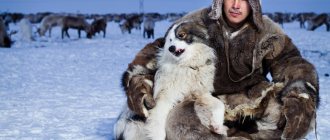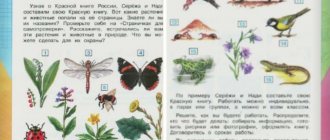Nature on a large scale feels the negative impact of human activity, which absolutely thoughtlessly litters both land and water areas with various, and sometimes toxic, waste. In addition, people carry out uncontrolled fishing of fish and other representatives of the underwater world, and also exterminate various animals. As a result of such vigorous activity, numerous species were on the verge of extinction.
In order to somehow control the process and keep records of the population of many species, the Red Book of Russia was legalized. This book contains all objects of flora and fauna, and not just animals or fish. In the Red Book you can find many species of birds that are on the verge of extinction, as well as plants, both cultivated and wild, insects, mushrooms, etc.
Red Book of Animals of Russia - what is it?
Getting acquainted with the animals of the Red Book should begin in childhood. Children of primary school age will understand from a very young age that the destruction of animals should not be allowed. Children should be explained that the animal world should be protected, and that endangered rare species should be treated especially carefully.
This article is a tip for parents, teachers, and older children who want to find out for themselves and tell their children about the Red Book, to get acquainted with rare species of various animals listed in the Red Book. Brief descriptions and photographs of rare animals are presented here.
There are a huge number of animals in the world. But, unfortunately, many of them are at the stage of extinction. Populations of some animal species are gradually disappearing from the face of the globe; many species have already become extinct.
The reason for the decline in animal populations is primarily human activity. Most often, people can unknowingly harm not only animals, but also plants. This occurs as a result of environmental pollution by atmospheric toxic substances, deforestation, during the development of new lands and other anthropogenic actions. But, unfortunately, some people deliberately destroy animals. Such people are called poachers. For the sake of valuable fur, meat, and tusks, poachers destroy animals all over the world. The problem of poaching is very serious in many countries around the world.
The following animals no longer exist in nature:
- Tarpan horse
- Turanian tiger
- Sea cow
- Tour
Now these species can only be found on the pages of encyclopedias. But once they existed in our nature, they were a numerous part of the fauna.
Important: the Red Book was created . The book is called this because the color red symbolizes danger and anxiety. The book exists to draw the attention of all people to the existing problem of extinction of animal and plant species. The Red Book includes not only animals, but also rare species of plants and fungi. Our country also has a Red Book of Animals.
The pages of the Red Book have their own colors, which indicate:
- Black - the animals listed on these pages are already extinct.
- Red - indicates animals on the verge of extinction.
- Yellow - rare species of animals that are not yet extinct.
- Green—restored populations.
- White - species of animals that are in doubt of extinction.
The Red Book of the USSR first appeared in 1978. Since then, the book has been supplemented many times with new names of animals. The Red Book and the animals listed in it are protected by law. The Red Book is a state document.
There are regional books, in them you can see rare animals of a certain region. A lot of work is being done to identify rare and endangered species of animals. Some species are called into question, and the Red Book also makes it possible to preserve the number of rare animals and revive their population. For example, thanks to human protection and care, it was possible to restore such animal species as elk, river beaver, stag beetle, and belladonna.
Cetaceans
Cetaceans belong to the family of mammals and the order of cetaceans. Currently, there are several theories regarding the appearance of this category of animals. One of them suggests that they evolved from artiodactyl representatives, transferring their habitat to water. Another says that these two groups have always been similar, but separated from each other.
The largest number of cetaceans can be found in all the oceans of our planet and even in some freshwater lakes. Some species live exclusively on one hemisphere, while others can be found on both sides of the world.
Atlantic white-sided dolphin
The Atlantic white-sided dolphin is found exclusively in the North Atlantic. Some individuals were recorded in the Barents and Baltic Seas. They are found in places where the water temperature does not drop below 7.5 °C. The body length of these representatives is 2.8 meters, and the upper body is colored black, while the underbelly and head are colored white.
White-faced dolphin
A distinctive feature from other representatives of its genus is its black sides and fins. Having arrived to the shores of the Baltic Sea, you can confidently wait to meet this “handsome guy”.
Black Sea bottlenose dolphin
The Black Sea bottlenose dolphin is a whole genus, which includes three species that live throughout the world's oceans. The total population size does not exceed 9 thousand individuals. The bottlenose dolphin can reach a body length of 3.5 meters and a weight of up to 300 kilograms. The animal has a large skull and a brain with many convolutions.
Gray dolphin
The gray dolphin is a species of mammal in the dolphin family. It is the only representative of the genus of gray dolphins. Adults can reach a weight of up to 500 kilograms with a body length of up to 4 meters. Distributed in open and coastal waters throughout the world, with the exception of the western coast of Africa, northeastern South America and the polar seas.
Harbour porpoise
The porpoise is a member of the porpoise family. Their body length reaches 160 centimeters, and the average weight varies from 50 to 60 kilograms. The upper part of the body is dark gray with light sides and a white belly. Animals dive deep, but do not completely emerge from the water. They can form small flocks.
Lesser killer whale
The small killer whale, despite its name, can reach 4-6 meters in body length. It is black or dark gray in color with a distinctive white stripe on the ventral side. On the territory of Russia it is found in the waters around the southern part of the Kuril ridge. Distributed in temperate and warm latitudes of the World Ocean.
killer whale
The killer whale is the largest representative of carnivorous dolphins. They feed on all living things: fish, cephalopods, marine mammals, etc. Distributed throughout almost the entire World Ocean, they are also found near the coast and in open waters. In Russia they are found near the Kuril ridge and the Commander Islands.
Narwhal (sea unicorn)
A narwhal is a toothed whale that is a member of the narwhal family. Has external similarities with a beluga whale. A distinctive feature of the narwhal is a long tusk growing from the upper jaw and twisted in a left-handed spiral. It grows throughout its life, reaching 1.5 - 3 meters in length. Animals live in the Arctic waters of Greenland, Canada and Russia all year round.
Highbrow Bottlenose
The high-browed bottlenose is small in size compared to other cetacean species. The length of an adult reaches 10 meters. They are found mainly in the waters of the North Atlantic, off the coast of North America and Europe. In the northern regions it often appears among the ice near Greenland and Iceland.
Commander's Belttooth (Stanger's Belttooth)
The Commander's harttooth is also known as the Steineger's harttooth and belongs to the cetaceans of the beaked whale family. They are a very rare and poorly studied species. Body length reaches 5-6 meters. They are found in the North Pacific Ocean, as well as near the Commander Islands, Alaska, Vancouver, Oregon and British Columbia.
Gray whale
The gray whale is a marine mammal from the group of baleen whales. The body length of an adult varies from 11 to 15 meters with a weight of up to 35 tons. According to a number of characteristics, gray whales occupy an intermediate position between right whales and minke whales. They inhabit the northern part of the Pacific Ocean, but undergo regular seasonal migrations.
bowhead whale
The bowhead whale is a baleen whale that inhabited the polar regions of the Northern Hemisphere. Its body length can reach 20 meters, and its weight ranges from 75 to 100 tons. The body is dark in color with a massive head on which is a large curved mouth. Animals of this species live in cold waters with difficult climatic conditions.
Japanese right whale
The Japanese right whale is a member of the right whale family. In terms of external characteristics, it is almost indistinguishable from the North Atlantic right whale, but is slightly larger with a body length of up to 18.5 meters. Its habitat covers the northern part of the Pacific Ocean from the Sea of Okhotsk to the Bering Sea and the Gulf of Alaska.
Gorbach
A bright individual. It has an interesting swimming style: it arches its back. It got its name for this feature.
Northern blue whale
The northern blue whale is the nominate subspecies that served as the basis for the first description of the species by Carl Linnaeus. The body length of these representatives can reach 27 meters, and their weight ranges from 130 to 150 tons. They are found in the North Atlantic and North Pacific Oceans.
Northern fin whale (Herring whale)
The northern fin whale is also known as the herring whale and belongs to the order of cetaceans. The body length of an adult varies from 18 to 19 meters, and the weight can reach 50 tons. They have a slender body and a small head. They live in all oceans and seas from the Arctic to the Antarctic, widespread from the Barents Sea to the Azores.
Sei whale (Wilder whale)
Sei whale is a large striped animal with a body length of up to 20 meters and a weight of about 30 tons. The color on the back is predominantly dark, on the sides there are small light spots on a gray background, the belly can be gray or white. The sei whale is found in all oceans, preferring waters with temperatures from 8 to 25 °C.
Beaked whale
The marine cetacean is found in the waters of Kamchatka and the Far East. Adults grow up to 8 meters in length and weigh 2-3 tons.
Sperm whale
The sperm whale is the largest representative of toothed whales and the only one from the sperm whale family. Male sperm whales reach 20 meters in length and weigh about 50 tons, while females do not grow more than 15 meters and weigh 20 tons. You can meet sperm whales in the waters of the entire World Ocean, with the exception of the cold northern and southern regions.
Mammals of the Red Book of Russia: names, photos, descriptions
The list of endangered animal species is very long. We will list the most famous of them.
Amur tiger
One of the largest representatives of the cat family. In size it is second only to the Bengal tiger. The Amur or Ussuri tiger lives in the Russian Far East. The tiger is adapted to survive in cold conditions thanks to a thick layer of fat. Amur tigers live alone. Sometimes females can be found in a group. The weight of the animal can reach 250 kg. This species requires a huge territory in which it will be the owner (0.5-1 km). In the wild, a tiger lives 15 years; in captivity, it lives up to 20 years.
Amur tiger
Polar bear
A large predator that lives near the Bering and Chukchi Seas. The Chukotka range of polar bears is considered the largest in the world. High mortality among young animals is common among polar bears. 10-30% of cubs die, and bears reproduce slowly. This makes the species look vulnerable. The body weight of a male can reach 450 kg, and cubs are born weighing 700 grams. The polar bear is considered a symbol of the Arctic.
Polar bear
Red Wolf
A rare species of canid. The red wolf differs in many ways from its cousins, the gray wolves. It can be confused with a fox; it is distinguished by a reddish tint of its skin and a fluffy tail. Scientists put forward the opinion that it was not man who caused the extinction of this species, but nature. It is believed that gray wolves are to blame for the disappearance of their brothers, with whom red wolves cannot compete in strength.
Red Wolf
Bison
This huge representative of artiodactyls lives on average 23-25 years. Basically, bison live in nurseries. This is how their population is preserved. They are also released into the wild. Bison live in small herds consisting of females and calves. Bulls live alone. The bison, as a rule, does not attack humans and behaves calmly.
Bison
Altai mountain sheep
Lives in the mountainous regions of Altai, Eastern Siberia. Due to the fact that the species lives in hard-to-reach places, it is difficult to track its numbers. Mountain sheep are often attacked by wolves and other predators, which reduces their numbers. It is famous for its luxurious horns, which makes it a tasty prey for hunters.
Altai mountain sheep
Snow Leopard
Another name is snow leopard. A small part of the total number of snow leopards lives in Russia (10-20%). Habitat in Russia - Buryatia, Krasnoyarsk Territory, Altai, Khakassia. The snow leopard is a lithe big cat with a beautiful smoky gray coat and ringed spots. The snow leopard lives in the wild for about 13 years; in captivity, its lifespan increases to 21 years.
Irbis
bottlenose dolphin
Bottlenose dolphins are very friendly dolphins. They do not attack humans; on the contrary, they show interest. There are known cases when schools of bottlenose dolphins surrounded people in a ring, protecting them from sharks. There are also cases of bottlenose dolphins rescuing drowning surfers. These are very smart animals. It has been proven that in captivity they are often exposed to stress, which affects their life expectancy.
Dolphin
Caucasian European mink
It is a subspecies of the European mink. It lives in the Caucasus in small rivers and streams. For a long time, mink were destroyed in order to obtain valuable fur.
Caucasian mink
Canids
A dog can rightfully be called man’s faithful friend for many centuries. However, other mammals also belong to the canine family. Basically, this includes wild animals that have not yet been domesticated by humans.
Absolutely all representatives of canines are predators. Their main characteristic feature is the presence of a high level of intelligence. Canine ways of living in a pack, observing the hierarchy established there, raising their authority and gaining recognition among other individuals. During evolution, some representatives of the canid order disappeared forever.
Steppe fox
The fox of this species is small in size: body length is up to 60 cm. In summer, the animal’s fur is short and gray in color, and in winter it becomes thicker and longer, acquiring a light gray tint. The animal lives in semi-desert and steppe.
Blue Arctic fox
Animals of this species are under threat because people kill them for their snow-white fur, from which they sew clothes. Individuals of the blue fox live on the coast of the Bering Sea.
Red (mountain) wolf
In appearance the animal is similar to a fox. Because of its beautiful fiery red fur, hunters shot wolves, so now the population of the predator has sharply declined. At the moment, rare flocks of 12-15 individuals can be found in the Far East.
Arctic fox (arctic fox)
The arctic fox is also known as the common arctic fox. Belongs to mammals of the canine family. Widely distributed in the tundra and forest-tundra of Eurasia and North America. Often found on Arctic islands. The body length of arctic foxes varies from 50 to 80 centimeters with a tail of up to 30 centimeters. It has a lush fur coat that is yellowish-gray in summer and snow-white in winter.
Birds of the Red Book of Russia: names, photos, description
Important: There are a lot of birds in need of protection. Birds often become prey to predators and die. In addition, birds are dying out due to habitat pollution, deforestation, and drainage of swamps.
Below are several representatives of birds from the numerous list of endangered species. It’s worth knowing them in order to protect them and help you survive.
Red kite
The kite is a bird of prey of the hawk family. This is a medium sized bird. It reaches a length of about 70 cm. Having seen the prey, the kite flies down like a stone and grabs it with its sharp claws. On the territory of Russia it lives within the Kaliningrad and Pskov regions, as well as in the Caucasus. The reason for the extinction of kites is human hunting of these birds. Kites often prey on poultry, which causes people to have a negative attitude towards the species.
Red kite
Black stork
A bird of the Stork family with a characteristic black color. This bird avoids people and hides, so it is difficult to observe the life of a black stork.
Black stork
Mandarin duck
A small wood duck with bright colors. On the territory of Russia, the mandarin duck lives on Sakhalin, the Amur Region, and the Khabarovsk Territory. More often the mandarin duck can be found in nature reserves and zoos. In the wild, the mandarin duck builds nests in hollows near water and lives near bodies of water. She rarely dives, only if she is wounded. Chicks are very sensitive to cold and often die. This bird often becomes prey for raccoon dogs and people, which has greatly affected the population of the species.
Mandarin duck
Steppe and stone eagle
These two species are listed in the Red Book of Russia as endangered species. This large bird of the hawk family builds nests on the ground, in small bushes, and in rocks. Rarely builds a nest in a tree. It feeds on rodents, small birds, and carrion. Eagles, especially young ones, are dying out as a result of electric shock on power lines.
steppe eagle
Owl
A large predator from the owl family. The eagle owl is adapted to life in various areas, but most often settles away from humans. It feeds on mice, hedgehogs, small amphibians and birds. The eagle owl has a unique voice that changes depending on the situation. Eagle owls often die as a result of electric shock on power lines.
Owl
mountain goose
A migratory bird famous for its record high flight. A case of bar-headed geese flying at an altitude of 10 thousand meters was recorded. The bar-headed goose is an endangered species. There are about 1,500 individuals in total in Russia, most of them in Altai and a small part in Tuva.
mountain goose
Ptarmigan
Lives in tundra, taiga, forests. The white partridge changes its color depending on the season. In winter it is white, in summer it is brown. Leads a terrestrial lifestyle and takes off on rare occasions. When a severe winter begins in the habitat of the white partridge, it flies to warmer places.
Ptarmigan
Musteluns
Representatives of the mustelid family are small and medium-sized predators. Their weight can vary greatly - from 100 grams. Up to 40 kg. The length is also very different - from a few centimeters to one and a half meters. All mustelids have a special body structure. As a rule, they have it very long and elongated. Each animal also has excellent flexibility. This allows him to move quickly and hunt for food.
The vast majority of mustelids boast well-developed hair. The determining factor here is the cold habitats located in the northern regions.
European mink
The small animal is found in Russia in the region of Western Siberia and the Ural Mountains, and lives on the banks of reservoirs.
Dressing
The bandage or pereguzna is a unique exotic predator from the mustelidae family. In appearance it is similar to a ferret, but differs from it in its smaller size, blunt muzzle and large ears. The color of the dressing is very variegated and is distinguished by a bizarre alternation of white, yellow and black colors. This animal can be found in the north-west of Mongolia and China, as well as on the Balkan Peninsula and Western Asia.
Caucasian otter
The Caucasian otter is a small predator that in appearance resembles a marten or mink. It has an elongated body and leads the life of an active hunter. You can meet it in places in the Western Caucasus, in the Kuban or Kuma region, not far from the sea coasts. In the southern range it may extend beyond state borders.
Sea otter (sea otter)
The sea otter is a medium-sized animal with a body length of up to 140 centimeters and a weight of no more than 45 kilograms. The color of their body can be different: from light red to dark brown. There are also albino sea otters, which are completely white, and melanistic ones, which are completely black. Sea otters live off the coasts and coasts of California, Alaska and the far east of Russia.
Amphibians of the Red Book of Russia: names, photos, description
Amphibians are similar to reptiles and fish. This is a class of primitive vertebrate four-legged animals. The number of amphibians is decreasing due to human pollution of their habitat. Meanwhile, amphibians play an important role in nature. They eat insects that can harm both crops and be carriers of various diseases.
The following species of amphibians are listed in the Red Book of Russia:
Reed toad
It has a color ranging from sand to gray-olive. The body length is about 8 cm. The species can be recognized by the yellowish stripe located along the back. The skin of the reed toad is covered with tubercles. On the territory of Russia, only one habitat is known - the Kaliningrad region. The lifespan of this species is about 15 years. The toad lives in lowlands and loves well-warmed areas by the sun, bordering on humid places.
Reed toad
Caucasian toad
The largest representative of amphibians living in Russia. Body length is about 12.5 cm. The color of small frogs is orange, adult frogs are brown or grayish. The Caucasian toad lives in tree hollows and soil voids. A threat to the population of Caucasian toads is the striped raccoon, which feeds on this species.
Caucasian toad
Ussuri newt
A large tailed newt measuring about 9 cm. Lives in cold streams with a water temperature no higher than 12*C. A necessary condition for the life of the Ussuri newt is the presence of stones or pebbles on the shore, as well as high humidity of the shores. When in danger, the newt buries itself in stones. The Ussuri newt does not have lungs; it breathes through its skin, so it cannot tolerate dry skin.
Ussuri newt
Triton Karelina
Of the genus of newts, Karelin's newt is the largest. Some individuals can reach 18 cm in length. Habitat is the Crimean Peninsula. The skin of the Karelin newt is rough and has a coarse grain. Color: gray, brown with dark spots. The abdomen is yellow or orange. During the mating season, males develop a crest. Males live 8 years, females - 11 years.
Triton Karelina
Common newt
Males and females can only be distinguished during the mating season. The male develops a crest and becomes larger in size than the female. The common newt has a distinctive feature - a longitudinal dark stripe passing through the eyes. In captivity, the common newt can live up to 20 years. In the natural environment, the number of newts is declining due to pollution of water bodies. It is known that in its natural habitat the newt lives no longer than 6 years. Syrian spadefoot. An amphibian similar to a frog, but separated into a separate genus - spadefoot. The Syrian spadefoot has large, bulging eyes with vertical pupils. In Russia it lives in the delta of the Samur River.
Common newt
Hyenas
Hyenas belong to the predatory representatives of the mammal family. Many people call hyenas dogs, perhaps because of their external resemblance. However, this opinion is erroneous. In fact, they are related to cats.
The hyena can rightfully be called one of the most controversial and externally repulsive predators. Even when pronouncing the name of this detachment, many people experience rejection. It's all because of her appearance. In fact, people in ancient times tamed hyenas quite easily. After a short period of time, the hyena willingly lived with the man, followed him everywhere, replaced the dog and even followed commands.
Striped hyena
The striped hyena is a large animal with a body height of up to 80 centimeters and a weight of up to 60 kilograms. It has a short body, which is emphasized by a mane of coarse hair up to 30 centimeters long. It is found throughout northern Africa, as well as in some regions of Asia from the Mediterranean Sea to the Bay of Bengal. Widely distributed in India and other countries further east.
Insects of the Red Book of Russia: names, photos, description
In Russia, insects were not included in the Red Book immediately after the book was published. Only 6 years later, namely in 1984, a list of insects in need of protection was published. After the October Revolution, agriculture actively developed, but insect protection remained stagnant. This led to significant destruction of biotopes.
Currently, the Red Book of Russia includes about 100 species of insects.
These include:
Smooth bronze
A beetle measuring about 3 cm with a beautiful shiny green tint. Sometimes the color is copper-red. It lives on old trees; the larvae appear in the hollows of rotten trees. You can find bronze on overripe fruits on trees.
Smooth bronze
Stag beetle
The beetle got its name due to the peculiar structure of the upper jaws, similar to horns. Lives in deciduous forests. The decline in the population of this species is due to massive deforestation, as well as the destruction of the species by collectors. Often beetles are not destroyed on purpose.
Stag beetle
Krasotel fragrant
A species from the genus of ground beetles. Unlike many ground beetles, the fragrant beetle flies well and moves deftly along the branches and trunk of a tree. This beetle feeds on caterpillars and pupae. In case of danger, it releases a substance with a strong odor. You can recognize this beetle by its color: its head has a blue tint, and its wing covers are blue-green with a golden tint.
Krasotel fragrant
Golubyanka Filipeva
A species of butterfly whose numbers have reached a critically low level. There are about 6 known habitats of Filipiev's blueberry. In Russia it can be found in the south of Primorsky Krai in low bushes along river banks. The color of the upper wings is violet-blue, the lower ones are grayish with black splashes.
Golubyanka Filipeva
Wax bee
A species of social bees with a very small habitat in Russia. Lives in hollows of old trees. The number of wax bees is rapidly declining. There is information that there are about 60 families of wax bees in total. Another name is Chinese wax bee.
Chinese wax bee
Woodcutter
A massive beetle with large mustaches. Dimensions: females can reach a body length of 6 cm, and males 4 cm. The largest representative of the genus of woodcutter beetles is the relict woodcutter. The size of males can reach 10 cm. The color is rich brown. In Russia, such beetles can be found on the Black Sea coast, as well as in the Caucasus.
Woodcutter beetle
Pinnipeds
Pinnipeds belong to the group of marine mammals. Their peculiarity lies in the fact that until now zoologists have not come to a consensus about which group these animals belong to. Some consider them predators, others prefer to separate them into a separate category.
The largest populations of pinnipeds are found in the Atlantic and Pacific Oceans. There are also many representatives in Antarctic waters. Some individuals also live in fresh water bodies, including Lake Baikal. Only a few individuals can be found in the Indian Ocean. This is explained by the water temperature in it being too high and uncomfortable for pinnipeds.
harbor seal
The common seal has spread to the northern and coastal areas of the Atlantic and Pacific oceans, as well as the Baltic and North seas. The distribution area of common seals is highly fragmented and is divided into Pacific and Atlantic. Animals are distinguished by a unique pattern on their body, and color may differ from individual to individual.
Sea lion
This individual reaches a length of 3 meters and weighs one ton. This eared seal lives in Kamchatka and Alaska.
Atlantic Walrus
The habitat of this representative is the waters of the Barents and Kara Seas. The maximum size that the presented individual can reach is 4 meters. Its weight is also considerable - one and a half tons. There were times when this species practically disappeared. However, with the help of specialists, this individual has a slight increase in popularity.
Caspian seal
The Caspian seal is a species of true seal from the order of carnivores. This representative is endemic to the Caspian Sea. In winter and early spring it migrates to the northern part of the sea, where it forms aggregations on the ice, whelps and molts, and by autumn it enters the mouths of the Volga and Ural. Endangered due to sea pollution.
Gray seal
The gray seal is a fairly large representative of real seals with a body length of up to 3 meters and a weight ranging from 150 to 300 kilograms. Gray seals have spread widely in the temperate zone of the North Atlantic, as well as throughout the Baltic Sea, including the Gulf of Finland, Riga and partly the Gulf of Bothnia.
Monk Seal
The monk seal is a representative of the genus of pinniped mammals of the true seal family. They are distinguished by widely spaced zygomatic arches of the skull and a slightly expanded nasal region. The number of these representatives is extremely small, therefore all species of these animals are included in the IUCN Red Book.
Ringed seal
The seal is small in size, and an adult grows up to 1.5 m, has light gray fur, and has well-developed sensory organs. Found in the Baltic Sea and Lake Ladoga.
Reptiles of the Red Book of Russia: names, photos, description
Among reptiles there are also species that are protected and cannot be destroyed. These types include:
Far Eastern turtle
This type of turtle belongs to the soft-bodied turtles. In Asia, the Far Eastern tortoise is a common sight. The meat of this turtle is known to be eaten. However, on the territory of Russia the species is listed in the Red Book; such a turtle can be found on the territory of our country in small habitats in the south of the Far East.
Far Eastern turtle
Gray gecko
A very small lizard no more than 5 cm. In other countries, the gray gecko is not a rare species. In Russia, the gray gecko is considered to be on the verge of extinction or a completely extinct species. The last location of the gray gecko on the territory of the Chechen Republic. The gray gecko loves to live in dry desert areas, desert or semi-desert areas.
Gray gecko
Medium lizard
The largest of the genus of green lizards. The body length can reach 17 cm, and the tail length - 25 cm. Young lizards are brown in color, and adults are rich green with black spots. On the territory of Russia, the average lizard lives in two places: Dagestan and Krasnodar region.
Medium lizard
Poloz
A snake from the genus Colubrida. Several species of snakes are included in the Red Book of Russia: Transcaucasian, Aesculapian, Japanese, striped, thin-tailed. Some species in Russia can be found extremely rarely. For example, the Japanese snake lives only on the Kuril Islands. The Transcaucasian snake lives in the Caucasus. The number of snakes is declining due to the destruction of nests and the destruction of snakes.
Aesculapian snake
cat snake
The species belongs to the Colubridae family. The snake's pupils are vertical, the head is separated from the body by an interception. Color: gray, maybe pinkish. Body flattened laterally. Lives in the territory of Dagestan. Loves slopes with sparse vegetation. Good at climbing trees and walls. In the hot season, the activity of the cat snake begins at night.
cat snake
Gyurza
One of the most dangerous snakes for humans and animals. The viper is the largest representative of the viper family. Its length can reach 2 m. Moreover, in a dangerous situation, the viper can make lunges equal to the length of its body. Even experienced snake catchers fell prey to the viper. The snake can live in various biotopes, but is most often found near springs, rivers and reservoirs.
Gyurza
Caucasian viper
The venom of the Caucasian viper is deadly to humans. The snake is characterized by a bright color, often black, as well as red and orange. Juveniles are brown. Males are smaller in size than females. The snake lives in deciduous forests, lives in vineyards and gardens.
Caucasian viper
Squeaky gecko
This is a very small lizard measuring no more than 4 cm. The color of the gecko is pale yellow with a grayish coating. The belly is white with lemon. In Russia, you can often find the squeaky gecko in the vastness of the Astrakhan region. Lives in desert areas.
Squeaky gecko
Bearish
The bear order belongs to the mammal family. According to some important characteristics, they are very similar to the canid group. However, there are some important differences between these mammal species. Representatives of the bear order are distinguished by a stockier build and larger size.
Predators of the order Ursidae are the youngest group, the isolation of which occurred relatively recently. The first representatives were small. Then the size of the individual gradually increased, which made it possible to distinguish them into a separate group, separating them from the canine family.
Polar bear
It is rightfully considered the largest representative of the “bear family”. In size it surpasses even the well-known grizzly bear.
Brown bear
The brown bear is also known as the common bear and belongs to the predatory mammals of the bear family. The largest and most dangerous species of land predators with a powerful and well-developed body. It has the typical appearance of all bear representatives. It is found in the territory from England to the Japanese Islands, as well as from Alaska to central Mexico.
The rarest animals of the Red Book of the World: list, names, description
Important: The problem of declining animal numbers is observed all over the world. Despite hunting bans and special attention to certain species of animals, the numbers of some species continue to approach zero. Below is a list of the rarest animals in the world that risk ending up in the near future only on the pages of encyclopedias and photographs.
The rarest animals in the world:
- Florida cougar . At last count, there are 230 individuals of this species in the natural environment. The Florida cougar lives in southern Florida in a nature reserve. The only enemy of the Florida cougar is the large alligator. Several factors led to the extinction of the species: scarce genetic material, which resulted in crossing with closely related animals, sport hunting and drainage of the swamps in which this animal likes to live.
- Hirola . This is a rare species of antelope in Africa. The number of hirolas is negligible; there are doubts about whether hirolas still exist, or whether the species is completely extinct. Hirols have long uneven horns, a long face, and a long body. They feed on grass vegetation. When the grass runs out, they migrate to another place. They go without water for a long time due to decreased activity. They are most active in the morning and evening.
- Sumatran rhinoceros . The smallest representative of rhinoceroses. There are several populations; keeping records of Sumatran rhinoceroses and monitoring their lives is difficult due to the animal’s solitary lifestyle. The Sumatran rhinoceros leads a solitary lifestyle, with the exception of the period of birth and nursing the baby. The habits and lifestyle of the animal have not been sufficiently studied, which makes it difficult to keep this species in captivity.
The list of animals is quite long. But this is only a small part of the animals that are on the verge of extinction. Some animals disappear due to natural disasters, but most of them are due to human cruelty and too active human activity. Animals are our little brothers, we must take care of them.








